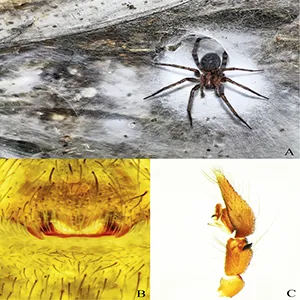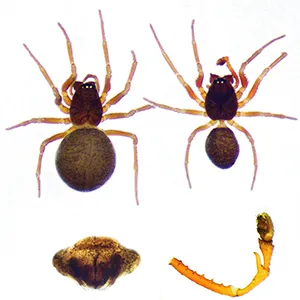
Massive colony of 111,000 spiders from different species found deep inside a sulfur cave
Deep underground on the Albania-Greece border, scientists have discovered something astonishing – a single, sprawling spider metropolis woven across a cave wall.
Covering roughly 1,140 square feet, the web shelters an estimated 111,000 spiders from two typically solitary species, all thriving together in total darkness beside a sulfur-rich stream.
This massive, cooperative structure – unlike anything seen before in either species – suggests that under the right conditions, even solitary spiders can become social builders.
Solitary spiders turn social in cave
The discovery was led by István Urák, an ecologist at the Sapientia Hungarian University of Transylvania (SHU). His research focuses on cave biodiversity and food webs.
These spiders normally keep to themselves, yet here they share a vast, layered sheet stitched from thousands of funnel retreats. The team identified domestic house spiders and Prinerigone vagans as cohabitants without open conflict.
This is the first documented colonial web for either species, which sets a new behavioral benchmark. The finding is not a fluke seen once and gone, since counts repeated across seasons pointed to a stable structure.
Sulfur and bacteria fuel spider cave
The cave’s engine is chemoautotrophic – life that produces food from chemical reactions rather than sunlight. Bacteria oxidize sulfur in the stream, and their biofilms support swarms of tiny midges.
To map energy flow, scientists used stable isotope analysis (SIA) – a method that tracks heavier and lighter forms of carbon and nitrogen to infer diet and position in the food chain. These isotopes are a standard toolkit for ecologists.
The isotope pattern in cave spiders and midges matched a food web fueled inside the cave – not imported from outside.
That pattern makes sense in a sulfidic setting, a place rich in hydrogen sulfide gas that feeds sulfur oxidizers.
Chemosynthesis-based cave communities have been known since the late 1980s at Romania’s Movile Cave, where invertebrate food webs draw carbon from bacteria rather than plants. That original ecosystem showed how a sealed world can run without sunlight.
Spiders unite in the dark
The cave swarm of chironomid midges supplies steady prey year-round. Abundant, reliable food can push spiders toward group living when it boosts capture rates.
Across species, high prey density has been linked to larger spider groups and stronger social tendencies. Prior research points to prey size and availability as key drivers.
The study team argues that darkness may blunt visual targeting, which could lower aggression toward smaller neighbors. In that context, coexistence becomes cheaper and cooperation pays.
“Our findings unveil a unique case of facultative coloniality in this cosmopolitan spider, likely driven by resource abundance in a chemoautotrophic cave,” said Urák.

Clues from genes and microbes
DNA barcoding showed that the cave populations are distinct from nearby surface spiders. That pattern supports an early haplotype divergence – a set of linked DNA variants inherited together – within the cave.
Microbial profiling found fewer bacterial partners inside the cave spiders compared with a surface counterpart. The microbiome, the community of microbes living in a host, leaned toward intracellular symbionts in cave individuals.
Together, these findings point to a population adapting to a harsh habitat – a stable, dark corridor with constant food made by chemistry.
Measuring a spider metropolis
Researchers measured the webbed wall and estimated its area at about 1,140 square feet (106 square meters). They sampled quadrats, counted funnel centers, and extrapolated to the entire patch.
Their estimate yielded about 69,000 domestic house spiders and around 42,000 P. vagans. The team noted that abandoned funnels may slightly inflate totals.
Egg clutches in early summer were larger than those in fall and late winter. The mean clutch size hovered near the mid teens, which is small compared with some surface reports.
The colony sits roughly 164 feet (50 meters) from the entrance, where the roof pinches low. That narrow passage traps midges that hatch from the stream and rest on the wall.

Cave isolation shapes spider behavior
Why two solitary species tolerate each other at such scale remains an open question. Chemical cues, low light, and constant prey likely interact.
Predator pressure and disease could shape colony edges over time. So could subtle shifts in gas levels and water chemistry.
Long-term, genetic isolation may matter as much as food. If dispersal stays rare, the cave lineages could drift further from their outside cousins.
Future work will need repeated genetic sampling, behavioral trials in controlled light, and fine-scale mapping of prey flux. All three could test how much each factor contributes.

Lessons from the spider cave
The spider discovery in the sulfur cave forces scientists to rethink how social behavior evolves in harsh ecosystems.
The research shows that cooperation can emerge not from kinship or intelligence but from environmental logic, when survival itself demands collective adaptation to extreme conditions.
When constant food supply meets physical isolation, cooperation may appear not as a rare exception but as an efficient survival strategy.
This colony shows that even typically solitary animals can shift social structures if environmental pressures align.
Beyond arachnids, the finding raises questions about other cave organisms living in chemically sustained systems.
If similar patterns exist in insects, crustaceans, or worms, these “dark ecosystems” could reveal early models of cooperation shaped by chemical energy rather than sunlight.
The cave, in this sense, acts as a natural experiment in evolution under isolation and abundance.
The study is published in the journal Subterranean Biology.
—–
Like what you read? Subscribe to our newsletter for engaging articles, exclusive content, and the latest updates.
Check us out on EarthSnap, a free app brought to you by Eric Ralls and Earth.com.
—–













